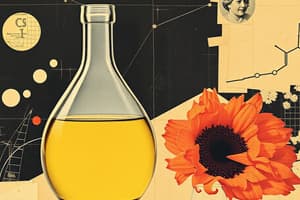Podcast
Questions and Answers
What is a common characteristic of esters in terms of density compared to primary alcohols?
What is a common characteristic of esters in terms of density compared to primary alcohols?
- Density varies significantly from primary alcohols
- Less dense than primary alcohols (correct)
- Equally dense as primary alcohols
- More dense than primary alcohols
Which of the following is a reaction that involves amines and produces amides?
Which of the following is a reaction that involves amines and produces amides?
- Hydrolysis
- Dehydration synthesis
- Ammonia/Amines reaction (correct)
- Esterification
What color are esters in their pure form?
What color are esters in their pure form?
- Bright yellow
- Light green
- Transparent blue
- Colorless (correct)
Which of the following is NOT a common use of esters?
Which of the following is NOT a common use of esters?
What is one of the roles of esters when used as solvents?
What is one of the roles of esters when used as solvents?
What process involves the formation of a molecule by removing water from a carboxylic acid and a thiol?
What process involves the formation of a molecule by removing water from a carboxylic acid and a thiol?
Which of the following components is primarily involved in the synthesis of molecules from a thiol and a carboxylic acid?
Which of the following components is primarily involved in the synthesis of molecules from a thiol and a carboxylic acid?
What is the primary byproduct formed during the synthesis involving a carboxylic acid and a thiol?
What is the primary byproduct formed during the synthesis involving a carboxylic acid and a thiol?
What is the outcome of the reaction between a carboxylic acid and a thiol when water is removed?
What is the outcome of the reaction between a carboxylic acid and a thiol when water is removed?
During the synthesis involving a carboxylic acid and a thiol, what role does water play?
During the synthesis involving a carboxylic acid and a thiol, what role does water play?
What is the correct way to name the alcohol part of an ester?
What is the correct way to name the alcohol part of an ester?
When naming the acid part of an ester, what should be done to the '-ic acid' ending?
When naming the acid part of an ester, what should be done to the '-ic acid' ending?
Which part of an ester is named first during the naming process?
Which part of an ester is named first during the naming process?
In the process of naming an ester, what must be modified in the alcohol part's name?
In the process of naming an ester, what must be modified in the alcohol part's name?
What is the final suffix used in naming the acid part of an ester?
What is the final suffix used in naming the acid part of an ester?
What is created when the hydroxyl group of a carboxylic acid is replaced by a chlorine atom?
What is created when the hydroxyl group of a carboxylic acid is replaced by a chlorine atom?
What property characterizes compounds derived from carboxylic acids with chlorine?
What property characterizes compounds derived from carboxylic acids with chlorine?
For what common purpose are compounds derived from carboxylic acids with a chlorine atom typically used?
For what common purpose are compounds derived from carboxylic acids with a chlorine atom typically used?
Which functional group is replaced in a carboxylic acid to create a chlorine derivative?
Which functional group is replaced in a carboxylic acid to create a chlorine derivative?
Which of the following is NOT a characteristic of compounds formed from carboxylic acids with chlorine?
Which of the following is NOT a characteristic of compounds formed from carboxylic acids with chlorine?
What structural change occurs to amines when they react with other chemicals according to the provided content?
What structural change occurs to amines when they react with other chemicals according to the provided content?
What is a notable feature of the reaction between amines and nitrous acid?
What is a notable feature of the reaction between amines and nitrous acid?
In the context of amines, what role do they play in producing plastics?
In the context of amines, what role do they play in producing plastics?
Which of the following is NOT a reaction type associated with amines?
Which of the following is NOT a reaction type associated with amines?
What is one potential outcome of the reaction of amines with other chemicals?
What is one potential outcome of the reaction of amines with other chemicals?
Study Notes
Esters
- Esters are formed by the reaction of an alcohol and an acid.
- To name an ester, first name the alcohol part, replacing the "-anol" ending with "-yl" and then name the acid part, replacing the "-ic acid" ending with "-oate".
- Esters have a lower density than water.
- Esters are generally colorless.
- Esters react with ammonia or amines in the presence of a catalyst to produce amides.
Uses of Esters
- Esters are commonly used as fragrances and flavors, for example, in perfumes and foods.
- Esters are used as solvents in paints, adhesives, and other applications.
- Esters are used as starting materials in the synthesis of other molecules.
Acyl Chlorides
- Acyl chlorides are compounds derived from carboxylic acids by replacing the hydroxyl group (-OH) of the carboxyl group (-COOH) with a chlorine atom (-Cl).
- Acyl chlorides are highly reactive and commonly used to make esters and other materials, such as plastics.
Amines
- Amines can undergo alkylation, which means they can react with other chemicals to add new groups of atoms to the nitrogen atom.
- Amines react with nitrous acid in a way that depends on the type of amine present.
Studying That Suits You
Use AI to generate personalized quizzes and flashcards to suit your learning preferences.
Related Documents
Description
This quiz covers the formation, naming, and uses of esters and acyl chlorides, as well as their reactions with amines. Understand the properties of esters and their significance in various applications such as flavors, fragrances, and solvents.




